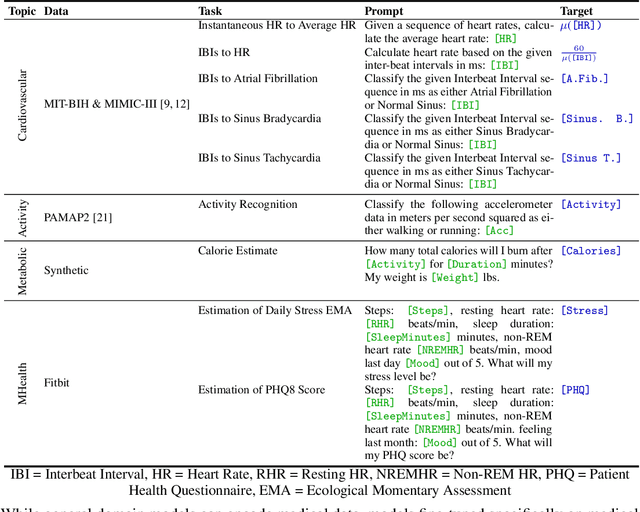Ming-Zher Poh
RADAR: Benchmarking Language Models on Imperfect Tabular Data
Jun 09, 2025Abstract:Language models (LMs) are increasingly being deployed to perform autonomous data analyses. However, their data awareness -- the ability to recognize, reason over, and appropriately handle data artifacts such as missing values, outliers, and logical inconsistencies -- remains underexplored. These artifacts are especially common in real-world tabular data and, if mishandled, can significantly compromise the validity of analytical conclusions. To address this gap, we present RADAR, a benchmark for systematically evaluating data-aware reasoning on tabular data. We develop a framework to simulate data artifacts via programmatic perturbations to enable targeted evaluation of model behavior. RADAR comprises 2980 table query pairs, grounded in real-world data spanning 9 domains and 5 data artifact types. In addition to evaluating artifact handling, RADAR systematically varies table size to study how reasoning performance holds when increasing table size. Our evaluation reveals that, despite decent performance on tables without data artifacts, frontier models degrade significantly when data artifacts are introduced, exposing critical gaps in their capacity for robust, data-aware analysis. Designed to be flexible and extensible, RADAR supports diverse perturbation types and controllable table sizes, offering a valuable resource for advancing tabular reasoning.
LSM-2: Learning from Incomplete Wearable Sensor Data
Jun 05, 2025Abstract:Foundation models, a cornerstone of recent advancements in machine learning, have predominantly thrived on complete and well-structured data. Wearable sensor data frequently suffers from significant missingness, posing a substantial challenge for self-supervised learning (SSL) models that typically assume complete data inputs. This paper introduces the second generation of Large Sensor Model (LSM-2) with Adaptive and Inherited Masking (AIM), a novel SSL approach that learns robust representations directly from incomplete data without requiring explicit imputation. AIM's core novelty lies in its use of learnable mask tokens to model both existing ("inherited") and artificially introduced missingness, enabling it to robustly handle fragmented real-world data during inference. Pre-trained on an extensive dataset of 40M hours of day-long multimodal sensor data, our LSM-2 with AIM achieves the best performance across a diverse range of tasks, including classification, regression and generative modeling. Furthermore, LSM-2 with AIM exhibits superior scaling performance, and critically, maintains high performance even under targeted missingness scenarios, reflecting clinically coherent patterns, such as the diagnostic value of nighttime biosignals for hypertension prediction. This makes AIM a more reliable choice for real-world wearable data applications.
Passive Heart Rate Monitoring During Smartphone Use in Everyday Life
Mar 04, 2025Abstract:Resting heart rate (RHR) is an important biomarker of cardiovascular health and mortality, but tracking it longitudinally generally requires a wearable device, limiting its availability. We present PHRM, a deep learning system for passive heart rate (HR) and RHR measurements during everyday smartphone use, using facial video-based photoplethysmography. Our system was developed using 225,773 videos from 495 participants and validated on 185,970 videos from 205 participants in laboratory and free-living conditions, representing the largest validation study of its kind. Compared to reference electrocardiogram, PHRM achieved a mean absolute percentage error (MAPE) < 10% for HR measurements across three skin tone groups of light, medium and dark pigmentation; MAPE for each skin tone group was non-inferior versus the others. Daily RHR measured by PHRM had a mean absolute error < 5 bpm compared to a wearable HR tracker, and was associated with known risk factors. These results highlight the potential of smartphones to enable passive and equitable heart health monitoring.
Large Language Models are Few-Shot Health Learners
May 24, 2023



Abstract:Large language models (LLMs) can capture rich representations of concepts that are useful for real-world tasks. However, language alone is limited. While existing LLMs excel at text-based inferences, health applications require that models be grounded in numerical data (e.g., vital signs, laboratory values in clinical domains; steps, movement in the wellness domain) that is not easily or readily expressed as text in existing training corpus. We demonstrate that with only few-shot tuning, a large language model is capable of grounding various physiological and behavioral time-series data and making meaningful inferences on numerous health tasks for both clinical and wellness contexts. Using data from wearable and medical sensor recordings, we evaluate these capabilities on the tasks of cardiac signal analysis, physical activity recognition, metabolic calculation (e.g., calories burned), and estimation of stress reports and mental health screeners.
SimPer: Simple Self-Supervised Learning of Periodic Targets
Oct 06, 2022



Abstract:From human physiology to environmental evolution, important processes in nature often exhibit meaningful and strong periodic or quasi-periodic changes. Due to their inherent label scarcity, learning useful representations for periodic tasks with limited or no supervision is of great benefit. Yet, existing self-supervised learning (SSL) methods overlook the intrinsic periodicity in data, and fail to learn representations that capture periodic or frequency attributes. In this paper, we present SimPer, a simple contrastive SSL regime for learning periodic information in data. To exploit the periodic inductive bias, SimPer introduces customized augmentations, feature similarity measures, and a generalized contrastive loss for learning efficient and robust periodic representations. Extensive experiments on common real-world tasks in human behavior analysis, environmental sensing, and healthcare domains verify the superior performance of SimPer compared to state-of-the-art SSL methods, highlighting its intriguing properties including better data efficiency, robustness to spurious correlations, and generalization to distribution shifts. Code and data are available at: https://github.com/YyzHarry/SimPer.
 Add to Chrome
Add to Chrome Add to Firefox
Add to Firefox Add to Edge
Add to Edge